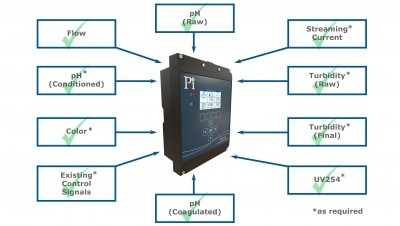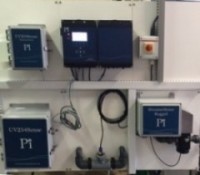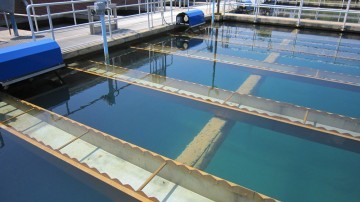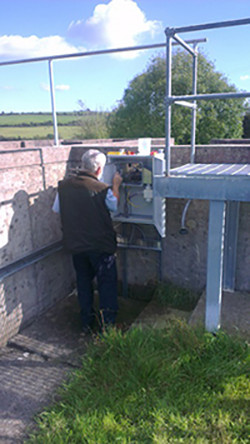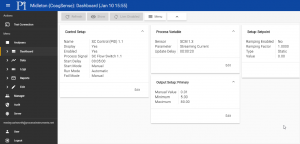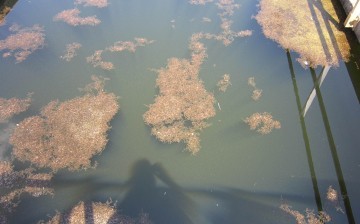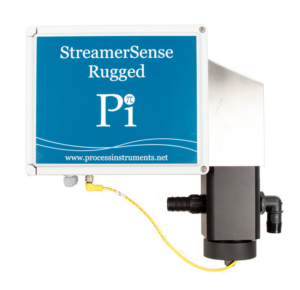Pi’s CoagSense coagulation controller is an integrated controller that accepts multiple inputs from appropriate parameters including pH, flow, temperature, UV254, turbidity and streaming current. From these measured parameters, the CoagSense outputs a flow proportional coagulation control signal that can go to a site SCADA or direct to control a coagulant dosing pump.
Coagulation is affected by multiple variables associated with and individual to any one water treatment site. These include but are not limited to:
- raw water pH, alkalinity, turbidity, organic loading, temperature
- coagulant used
- post coagulant pH, temperature
- physical aspects including dosing point, mixing etc.
These variables are typically different from site to site, water source to water source, and even day to day.
Pi believes that one size does not fit all. One method of coagulation control cannot be trialled at one site and rolled out across many. Each system needs to be designed and specified for each water treatment plant and that is a service offered by Pi.
Prior to changing existing controls, it may be beneficial to install and monitor how well an existing coagulation controller is doing by installing a coagulation analyzer.
Flow
– Used to increase or decrease the coagulant dose proportionally to the flow.
Raw Water pH
– Perhaps the single most important parameter affecting coagulation, Pi uses an extremely fast responding, reliable, solid polymeric junction pH sensor to alarm if the pH moves outside a predetermined range or preferably to control the pH of raw water on a separate PID loop.
Coagulant Water pH
– Used to alarm if the pH goes outside the predetermined range for optimum control.
UV254
– During periods of low turbidity and high SUVA¹, optimal organics and therefore THM removal can be achieved using feed forward control from a UVA signal.
Raw Water Turbidity
– When turbidity is high, UVA sensors become swamped and no longer effectively measure organics. During these periods another basis for control is often preferable and this can potentially be turbidity.
Streaming Current
– With the right water conditions and/or coagulant, streaming current feedback control can offer the simplest and most reliable coagulation control. Installed in over 5000 plants worldwide, streaming current monitors can offer a robust and cost effective solution. Understanding the relationship between pH and streaming current is essential for the successful implementation of a streaming current based coagulation controller. Streaming current measures all variables that affect charge neutralization, a key aspect of coagulation. If not used for control, a streaming current monitor can be extremely useful as a coagulation monitor, continuously monitoring for changes in any aspect of coagulation, including changes in water chemistry, coagulant make up and the dosing region such as the pump output.
References: 1. Edzwald, J. K. & Kaminski, G. S. A simple method for plant water optimization and operation of coagulation. (American Water Works Association, 2007).
- Configured and optimized for each site
- Stable and reliable
- Excellent process control
- Can interpret UV254, streaming current, pH, turbidity and flow
- Profibus, Modbus and TCP comms to SCADA
- Help and consulting available
Previous versions of multi-parameter systems have been PLC based, complex, extremely expensive and have rarely been described as ‘robust’ or ‘reliable’. Pi’s CoagSense coagulation analyzer is instrument based (stand alone) and fully configurable to manage variations between sites or variations within sites.
For many years, water companies have been looking to control coagulant dose on a single parameter. That parameter has been; pH, turbidity, streaming current or UV254. All of these parameters have been used to control coagulation on a water treatment plant with varying degrees of success.
The CoagSense coagulation analyzer from Pi allows for the control of coagulation on a water treatment plant using one or more, or all of these parameters.
Get more info on the coagulation controller
Please contact us by using the form below.
Many water treatment plants still use manual control for coagulant dosing (usually alum or ferric). Whilst the raw water quality is steady this is an effective method to get a coagulant dose, however when the raw water changes then manual control of the coagulant dose breaks down, particularly when plants are unmanned overnight or at the weekend. When the raw water is likely to be of proper quality in the future (e.g. a weather forecast predicts a rain event) operators often increase the coagulant dose in anticipation of a rainfall event. This can lead to poor coagulation prior to, during, and after the rainfall event (if it comes at all) and also can introduce longer term issues such as filter blinding, shorter filter run times and increased aluminum residuals (in the case of alum).
For many plants it is possible to automate coagulant control such that a streaming current monitor can effectively increase and decrease the dose of coagulant automatically in response to changing water quality. This is particularly common in areas of low alkalinity raw water.
The CoagSense coagulation controller can be used as a coagulation monitor (monitoring an existing system), a coagulation analyzer (providing information prior to installing a coagulation control philosophy) or a full scale coagulation controller, either stand alone or via SCADA.
The CoagSense can be configured with various sensors, flow cells, communications options and consultancy services to provide the water treatment plant professionals with everything they need to ensure optimal control.
Options include:
- Remote Access over LAN
- Remote Access over GPRS
- Modbus over LAN
- Modbus over RS458
- Site sensor inputs
- Data logging
- Onboard PID controls
- Direct coagulant pump control
- Coagulant pump control via SCADA
| Document | Type | Size |
|---|---|---|
CoagSense |
Brochure | 606kB |
Coagulation Control Using Streaming Current Monitoring |
Technical Note | 1.1mB |
CoagSense Application Questionnaire |
Technical Note | 512kB |
CRIUS® |
Brochure | 584kB |
CRIUS® Remote Communications |
Brochure | 573kB |
CRONOS® and CRIUS® Control Options |
Technical Note | 520kB |
Remote Access GPRS |
Technical Note | 554kB |
Focus Ons are a series of short articles distributed by email providing technical information regarding instrumentation, process measurement in potable, waste, process and pool waters. If you would like to join the mailing list, please contact us.
However, did you know that…
… no single online water quality measurement stands out as always being the best to monitor or control coagulation in all situations (as there are multiple factors that can affect coagulation)?
… some of these factors, like organics, are very critical to coagulation but are not commonly measured online and so are often overlooked?
… Process Instruments controllers can monitor multiple parameters simultaneously including charge (streaming current), organics (UV254), pH, flow rate and turbidity to provide a complete overview of water characteristics minute by minute?
What is coagulation control?
The aim of water treatment is to remove soluble (e.g. organics) and insoluble (e.g.colloidal particulate) contaminants. These contaminants often carry an anionic charge which keeps them in suspension or in the soluble phase. Coagulants are added to neutralize the charge of colloidal particles and to also “complex” with organic molecules which ultimately results in their precipitation. Reducing the charge of the particles and precipitating the organics means they will no longer be able to remain in a stabilized suspension. Once the repulsive charge component is removed these contaminants will naturally start to clump together due to attraction forces called Van Der Waals forces. The removal of these contaminants is aided by the formation of chemical floc (resulting from the hydrolization of the coagulant) that both enmeshes and sweeps up the smaller agglomerations so they can be removed more easily by sedimentation or floatation.
If the coagulant dosing is too high, the unnecessary additional coagulant can cause increased amounts of sludge to be generated, shorter filter run times, aluminum carry over, and other unwanted side effects.
This situation is made considerably more complex because the amount of coagulant required and the effectiveness of coagulation can vary greatly throughout the day or even hour by hour due to changes in turbidity, pH, temperature or the levels of natural organic material (NOM) of the incoming water.
What happens to the raw water entering a plant during a rainfall event?
The obvious answer is that incoming water gets more turbid and the coagulant dose goes up. Turbidity is used as an online measurement of water quality in virtually all WTP’s and also when jar tests are carried out, however turbidity is not the only water quality parameter that is changing. There are other factors which are critical to coagulation that are likely to be changing at the same time:
- Depending on the nature of the river the pH can change which in turn can increase or decrease coagulation efficiency. Each coagulant has an optimum pH range where it can achieve the highest efficiency in terms of turbidity and organics removal. Thus, changes in pH can have a considerable impact on coagulation and filtration performance, and resulting turbidity and DBP reduction.
- The alkalinity of the water can change. If this drops below around 10ppm then effective coagulation cannot occur because the hydrolysis reaction that is essential for coagulation cannot occur. This situation can only be rectified by adding alkalinity.
- The level of dissolved organics (NOM) can change. Unless monitored with appropriate instrumentation (preferably online), initial changes in organics often go unseen and under-treated as a result. The actual demand on a coagulant from organics can in some cases appear before an increase in turbidity is seen and can also remain elevated after the turbidity has returned to normal. Lack of proper instrumentation to monitor changes in organics as they occur leads to a reduced removal efficiency of NOM which can lead to the formation of Trihalomethanes and other unwanted disinfection by products.
So what is the best measurement to optimize and control coagulation?
The answer is that no one single water quality measurement provides the complete picture on its own. As has been discussed here, there are multiple factors that need to be taken into account and ideally monitored on a continuous and online basis in order to most effectively control coagulation. Expecting a single measurement parameter to be effective is simply not very practical because different water treatment plants all have different raw waters, which each have different challenges to overcome when controlling their coagulation dosing. This means that for any system to be most effective it needs to be flexible and modular, allowing different parameters to be measured based on what is needed at different water treatments plants, which depends greatly on the individual characteristics of the raw water. Even if a particular water treatment plant doesn’t currently face an issue like DBP formation due to elevated levels of organics, we have lots of examples where water quality has changed in unpredictable ways for a good many WTP’s. So, having a flexible, modular, and well rounded approach to online coagulation control, versus a single measurement approach, makes the most obvious sense.
The solution to this problem?
Not a ‘one size fits all’ product but a modular, customizable system designed to be flexible enough for all applications.
How we design your individual coagulation monitoring/control system.
At the heart of Pi’s coagulation monitoring/control systems is Pi’s CRIUS® CoagSense controller.
- First we will ask you for details about your particular application and water treatment challenges and from this discuss the parameters you may wish to monitor. These parameters will include one or more of the following: pH, temperature, conductivity, streaming current, UV254 and turbidity.
- We will then discuss what control and communication requirements you might need. How many dosing pumps, alarms or signal outputs are needed? Is flow pacing going to be required? Does the system run continuously or only certain hours of the day? Do you require remote access or integration with telemetry systems? If your SCADA will be handling control, then what sort of communication protocol is needed to get the measurement data integrated?
- Finally we will discuss the ideal system installation to get the most reliable performance out of your online coagulation control system.
Once this process is complete you will have a custom designed system, created by you, specifically for your needs with all the necessary features for effective control and no unnecessary extras. You will also have a system that can be easily expanded upon should it prove necessary at a later time, or as budgets allow.
Process Instruments Coagulation Controllers – truly bespoke systems.

















